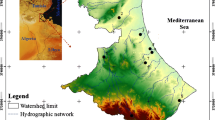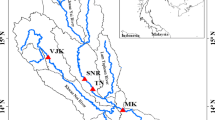Abstract
The Eastern Mediterranean region has been exposed to drought episodes, which have been occurring more frequently during the last decades. The objective of the present paper is to study the precipitation regime of the Damascus (Mazzeh) meteoric station by analysing drought characteristics using the Standardized Precipitation Index (SPI) and comparing this with the drought in Cyprus. The cumulative drought conceptis proposed to characterize long-term hydrologic drought, which affects the shallow groundwater productivity in terms of quantity and quality. Gamma probability distribution was fitted to the long-term annual precipitation in Damascus from 1918–1919 to 2007–2008 (n = 90 years). Generally, a decreasing trend of 17% to the mean annual rainfall of Damascus and 13% to the mean annual rainfall of Cyprus was estimated between 1970 and 2000. The SPI identifies three major extended drought periods: (1) 9 years of severe drought (1954–1963) with an average 20% precipitation deficit per year compared to the mean. (2) 8 years of severe drought (1983–1991) with a 27% deficit per year on average. (3) 9 years of extreme drought (1993–2002) with a 31% deficit per year on average. The cumulative standardized precipitation index (SPI 30) demonstrates positive values for the first period and is indicative of having no effect on the global water balance. SPI 30 exhibits sensitive equilibrium with near zero values / a near zero value (±1.5) for the second period. For the third period, however, the SPI 30 decreases below −10 indicating an extreme hydrological drought that has negative consequences on the recent groundwater recharge. It is required to develop and implement a sustainable groundwater management strategy to reduce long-terms drought risks. Generally, the SPI 30 in Cyprus is parallel to that in Damascus with a 3–5 year delay. Thus, the central zone of the Eastern Mediterranean region is facing big challenges and has been suffering from three decades of moderate to severe hydrological drought (SPI 30=−5 to −10) causing a severe decrease in springs discharges of the region. Therefore, in order to reduce the climate change effects on water resources, it is necessary to adopt a sustainable proactive management plan during the frequent severe droughts.








Similar content being viewed by others
References
Abou Zakhem B and Hafez R 2010 Climatic factors controlling chemical and isotopic characteristics of precipitation in Syria; Hydrol. Process. 24 (18) 2641–2654.
Abou Zakhem B and Hafez R 2012 Chemical and isotopic methods for management of artificial recharge in Mazraha station (Damascus Basin, Syria); Hydrol. Process. 26 3712–3724.
Abou Zakhem B and Kattaa B 2015 Cumulative drought effect on Figeh karstic spring discharge (Damascus basin, Syria); Environ. Earth Sci., doi:10.1007/s12665-015-5013-3.
Alammareen A 2010 Groundwater Exploration in Karst: Examples for Shallow Aquifers using Microgravity Technique in Paderborn-Germany and the Reconnaissance of Deep Aquifers in Catchment of Barada Spring-Syria; Doktor der Naturwissenschaften. der Technischen Universität Berlin, Germany, 318p.
Al-Charideh A 2011 Environmental isotope study of groundwater discharge from the large karst springs in West Syria: A case study of Figeh and Al-sin Springs; Environ. Earth Sci. 63 1–10.
Al-Charideh A 2012 Recharge rate estimation in the mountain karst aquifer system of Figeh Spring, Syria; Environ. Earth Sci. 65 1169–1178.
Bonaccorso B, Bordi I, Cancelliere A, Rossi G and Sutera A 2003 Spatial variability of drought: An analysis of SPI in Sicily; Water Resour. Manag. 17 273–296.
Cancelliere A, Di Mauro G, Bonaccorso B and Rossi G 2005 Stochastic forecasting of standardized precipitation index; In: Proceedings of XXXI IAHR Congress on Water Engineering for the Future: Choice and Challenges, Seoul, Korea, 11–16 September 2005, pp. 3252–3260.
Cancelliere A, Bonaccorso B and Di Mauro G 2006 A nonparametric approach for drought forecasting through the standardized precipitation index; Giornata di Studio: Metodi Statistici e Matematici per l’Analisi delle Serie Idrologiche- Viterbo.
Dai A 2011 Drought under global warming: A review; Wiley Interdisciplinary Reviews; Climate Change 2 (1) 45–65. doi:10.1002/wcc.81.
Eaid E 2000 Meteorological Conditions in Mediterranean Basin; General Meteorological Department, Damascus, Syria, 41p.
Edwards D C and McKee T B 1997 Characteristics of 20th century drought in the United States at multiple time scales; Climatology Report Number 97-2; Colorado State University, Fort Collins, Colorado.
El-Asrag A M 2005 Effect of synoptic and climatic situations on fractionation of stable isotopes in rainwater over Egypt and east Mediterranean; IAEA-TECDOC-1453, pp. 51–73.
Hajispyrou E, Pashardes P, Photiou C, Rostan di N and Tsiourtis N X 2007 Application of the drought management guidelines in Cyprus [Part 2. Examples of application]; In: Drought management guidelines technical annex (eds) Iglesias A, Moneo M and López-Francos A, Zaragoza: CIHEAM/EC MEDA Water, pp. 215–244 (Options Méditerranéennes: Série B. Etudes et Recherches n. 58).
Hamdy A 2004 Drought preparedness and mitigation in the Mediterranean region; In: Water Management for Drought Mitigation in the Mediterranean, Centre International de Hautes Etudes Agronomiques Méditerranéennes (CIHEAM), Options Méditerranéennes, Série B, N. 47, p. 328.
Hayes M J, Svoboda M, Le Comte D, Redmond K T and Pasteris P 2005 Drought monitoring: New tools for the 21st century; In: Drought and water crisis (ed.) Wilhite D A, Taylor and Francis, Boca Raton, Florida.
Heim R R 2000 Drought indices: A review; In: Drought: A Global Assessment (ed.) Wilhite D A, Routledge, London and New York.
Guttman N B 1999 Accepting the standardized precipitation index: A calculating algorithm; J. Amer. Water Resour. Assoc. 35 (2) 311–323.
IPCC 2007 Regional Climate Projections. Climate Change 2007: The Physical Science Basis; Contribution to Working Group I and to AR4 (Fourth Assessment Report of the Intergovernmental Panel on Climate Change) (eds) Solomon S, Qin D, Manning M, Chen Z, Marquis M, Averyt K B, Tignor M and Miller H L, Cambridge University Press, Cambridge, UK, pp. 847–940.
Kattan Z 1997 Environmental isotope study of the major karst springs in Damascus limestone aquifer systems: Case of the Figeh and Barada Springs; J. Hydrol. 193 161–182.
Kayyal M 2011 Climate Change and Utilities DAWSSA – Case Study; ACWUA, Best Practices Conference, 7–8 December 2011, Sharm el Sheikh, Egypt.
Loukas A and Vasiliades L 2004 Probabilistic analysis of drought spatiotemporal characteristics in Thessaly region, Greece; Natural Hazards and Earth Syst. Sci. 4 719–731.
McKee T B, Doesken N J and Kleist J 1993 The relationship of drought frequency and duration to time scales; In: Proceedings of the 8th Conference on Applied Climatology, Boston, MA, USA, Am. Meteorol. Soc. 17(22) 179–183.
McKee T B, Doesken N J and Kleist J 1995 Drought monitoring with multiple time scales, Preprints, 9th Conference on Applied Climatology, Dallas, TX, Am. Meteor. Soc., pp. 233–236.
MED WS and D WG 2007 Mediterranean Water Scarcity and Drought; Working Group: Technical report on water scarcity and drought management in the Mediterranean and the Water Framework Directive (Tec. Rep. 009-2007). EUWI/WFD Joint process, April 2007. http://www.emwis.net/topics/WaterScarcity.
Michaelides S and Pashiardis S 2008 Monitoring drought in Cyprus during the 2007–2008 hydrometeorological year by using the standardized precipitation index (SPI); European Water Publ. 23/24 123–131.
Mishra A K and Singh V P 2010 A review of drought concepts; J. Hydrol. 391 (1–2) 202–216.
Pashiardis S and Michaelides S 2008 Implementation of the standardized precipitation index (SPI) and the reconnaissance drought index (RDI) for regional drought assessment: A case study for Cyprus; European Water Publ. 23/24 57–65.
Ragab R and Hamdy A 2004 Water management strategies to combat drought in the semiarid regions; In: Water Management for Drought Mitigation in the Mediterranean, Centre International de Hautes Etudes Agronomiques Méditerranéennes (CIHEAM), Options Méditerranéennes, Série B, No. 47, p. 328.
Rossi G and Cancelliere A 2002 Early warning of drought: Development of a drought bulletin for Sicily; Proc. 2nd Int. Conf. “New Trends in Water and Environmental Engineering for Safety and Life: Eco-compatible Solutions for Aquatic Environments”, Capri, Italy, June 24–28, 2002, pp. 1–12.
Saigh O 2005 Isotopic composition of precipitation from Algiers and Assekrem; IAEA-TECDOC-1453, pp. 5–18.
Smiatek G, Kaspar S and Kunstmann H 2013 Hydrological climate change impact analysis for the Figeh Spring near Damascus, Syria; J. Hydrometeor. 1 577–593.
Thom H C S 1966 Some methods of climatological analysis; WMO Technical Note No. 81, Secretariat of the World Meteorological Organization, Geneva, Switzerland, 53p.
Turgu E 2008 Using standardized precipitation index for monitoring drought and analyzing drought; BALWOIS 2008 – Ohrid, Republic of Macedonia – 27, 31 May 2008.
United Nations 1982 Groundwater in Eastern Mediterranean and Western Asia; Natural Resources/Water Series n°9; United Nations: New York.
Vicente-Serrano S M, Gonzalez-Hidalgo J C, De Luis M and Raventos J 2004 Drought patterns in the Mediterranean area: The Valencia region (eastern Spain); Clim. Res. 26 5–15.
Wilhite D A and Glantz M H 1987 Understanding the drought phenomenon: The role of definition; In: Planning for Drought (eds) Wilhite D A, Eastrling W E and Wood D A, Vestview Press, Boulder, CO, pp. 11–27.
Acknowledgements
The authors would like to acknowledge Prof. I Othman, Director General of Atomic Energy Commission of Syria (AECS), for his guidance and support. Thanks are due to Dr. E. Eaid, Director General of Meteorological Department, Damascus, Syria for the valuable meteorological information. The authors would also like to thank Associate Editor of JESS, Prof. Subimal Ghosh and the reviewers for their constructive and valuable comments and suggestions. Finally, thanks to the colleagues in Geology Department (AECS).
Author information
Authors and Affiliations
Corresponding author
Additional information
Corresponding editor: Subimal Ghosh
Rights and permissions
About this article
Cite this article
ZAKHEM, B.A., KATTAA, B. Investigation of hydrological drought using Cumulative Standardized Precipitation Index (SPI 30) in the eastern Mediterranean region (Damascus, Syria). J Earth Syst Sci 125, 969–984 (2016). https://doi.org/10.1007/s12040-016-0703-0
Received:
Revised:
Accepted:
Published:
Issue Date:
DOI: https://doi.org/10.1007/s12040-016-0703-0




